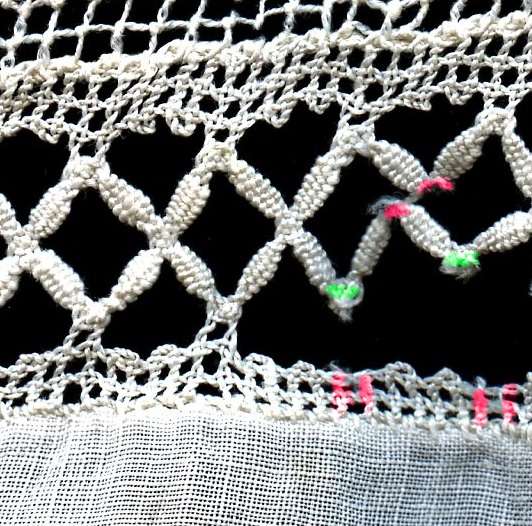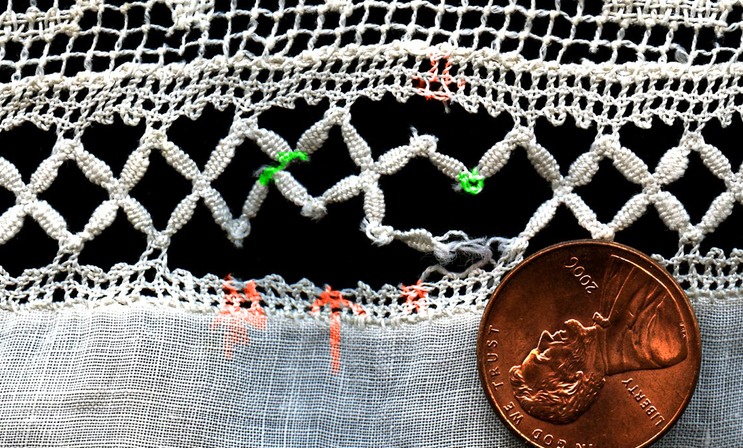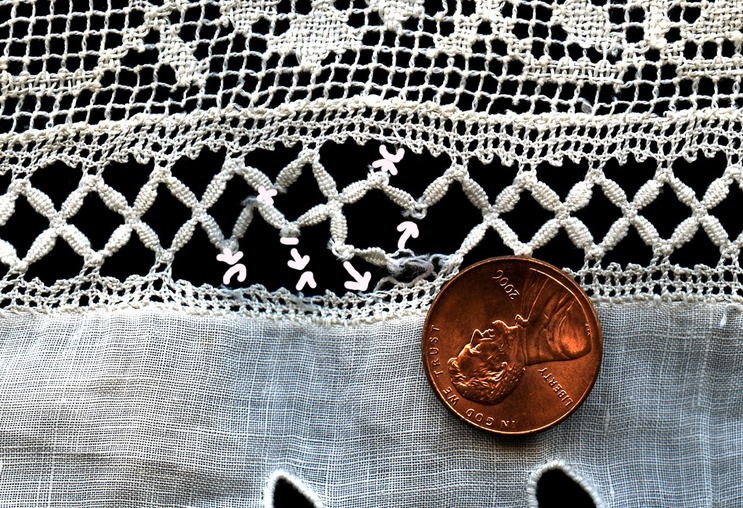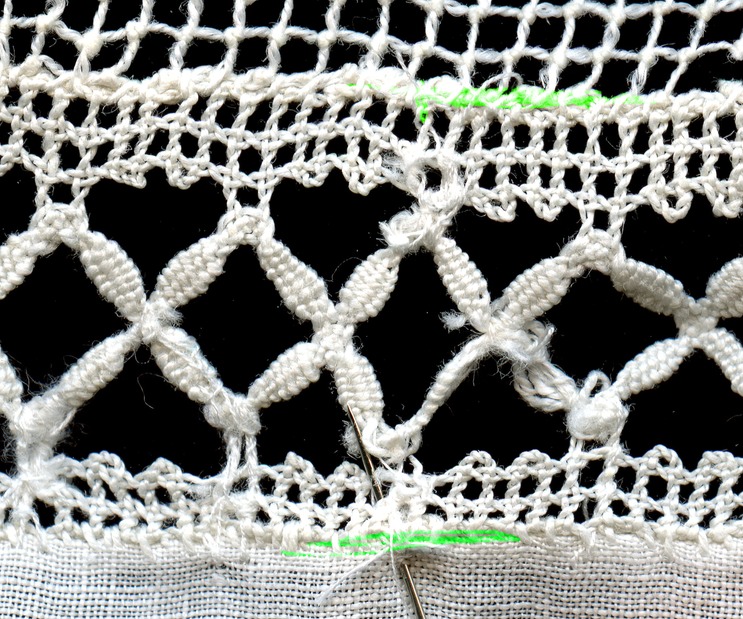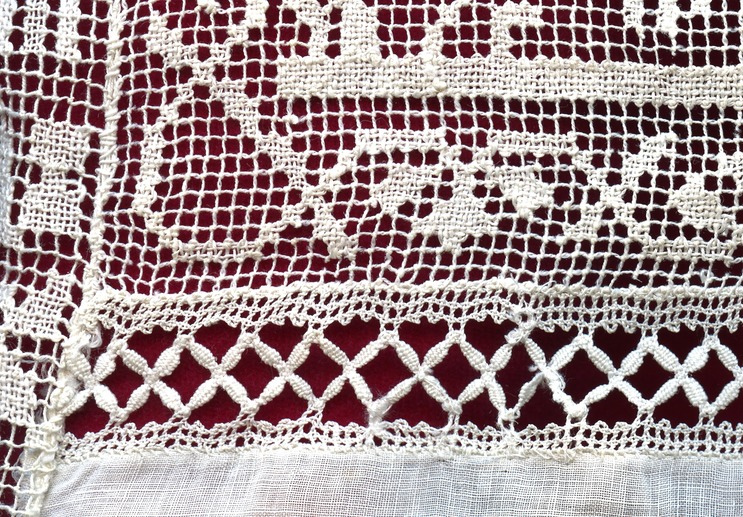
When this lengthy mixed lace piece showed up, the description sounded like a set-up for a joke -- “What do a squirrel, a rabbit, a couple of swans and Jupiter have in common?” And the answer is? Well, OK Jupiter IS the top of the food chain among Roman gods, so I suppose anything edible is truly fair game for Jupiter.
Or how about this one -- a TV game show. Like a gladiator the contestant has entered the ring. It’s a circa-1900 window or door panel. OOPS. Who cares? Who even uses window panels anymore. That went out in the 1930s. Plus this one is wearing out, threads are breaking, the tallies are coming apart. The audience votes: Shall we Use it .... Or Lose it? Thumbs up, or thumbs down?
The techniques used to make the lace are filet lace for all the figures, cutwork for the fabric panels, and a little bit of bobbin lace used as separators. None of the lace is of exceptional quality, and its primary value is as a decorator piece. But what a delighful decorator piece!
It is a very long, skinny piece: 58 inches long, and about 11 inches wide -- just right for a narrow window flanking a door in a Victorian home.

Clues that it might have been some sort of panel to place in a long window or sidelight window for a door are casings (made of strips of machine lace) to slide it over a slender rod at the top and bottom, and the little rings along the scallopa along the edge to attach sides to a window frame.

Overall the piece is simply wearing out.

Some threads in the filet are broken and fraying (marked in red) And there is a broken section in the bobbin lace wheatears or tallies.

The cutwork has breaks, like this tear that looks disastrous.
Lace and linens that are wearing out usually are not worth mending, as they will continue to fray, break, and shred.
But how can you not like a bunny rabbit and a squirrel. And roosters, swans and doves. And who would give up on Jupiter? The design of this piece has so many elements that are so much fun it seems a shame to give up on it.
In spite of the damage, I voted thumbs up. Use it.
Let’s mend it as best we can, and give it another chance as a decorator piece. Long windows are back in again, and if it’s not used in a window, it could hang on the wall as a great display piece. That actually is a much better alternative -- sunshine would do in the lace in no time.
At this point, the whole is still worth more than the sum of the parts, but eventually the figural elements might be salvaged for pillows, framing, general decorating.
PLANNING A MENDING PROJECT
As always, the key questions in mending are what’s really wrong -- are things just broken, or are parts missing? How difficult would it be to mend it, and of course is it worth the time and effort. We have already determined that this is not a museum quality piece or something that should not be mended, or not mended by an amateur. With the enthusiastic attitude of "can't hurt, might help" let’s evaluate each type of mend, and see what can be done.
There are a few simple guidelines for a successful mend: Maintain the lines and spaces is the most important.

Starting with the whitework tear, let's follow that guideline.
If we align the sections carefully, we see it is a clean tear with nothing missing.

Using a very fine thread and very fine needle, it is possible to make the mend much less obvious.
If I had been more careful in making the darning stitches more closely parallel to the weaving it would have been even better!
But sometimes good enough is good enough. The purpose here was to get the job done quickly and make the piece serviceable.
Now we move on to mending the wheatear (tally) bobbin lace spacers. Key here is figuring out what is really wrong.
That means taking a VERY close look at the lace. Wheatears or tallies are made with four threads -- one thread is woven over-and-under the other three. Threads cross in the centers to go on to work the opposite wheatears.
If there is a break in the threads in the tallies, they normally unravel very fast. Most of the loose tallies have not unraveled. That is a big clue that the breaks are mostly not in the tallies, but in the edge part of the lace (red). There are also some breaks where the tallies cross (green below, red above). These have to be secured with a couple of stitches to make sure they do not unravel.
Then remember the first guideline: maintain the lines and spaces. To make a neat mend, the zig-zag tallies have to be realigned with their original positions.
When stitching the tallies back into place, remember the first issue -- the breaks in the edge lace. The tallies MUST be anchored to something secure -- not just the edge of the lace, because that has broken threads and will pull out of position and unravel if not securedl. Run the mending stitches all the way down to the fabric (green), a secure place to anchor the mend. On the top edge, the mend was anchored to the seam between the filet and bobbin lace. Using a very fine thread helps hide the mend, and is strong enough to hold. Be sure also to secure the edge threads when securing the tallies.
Finally, a few stitches over-and-under the threads in the unraveled tally to tidy that up. The mend is not perfect -- I perhaps could have been more careful in getting the joins smaller and tidier, but one does what one can with stiff fingers and trifocals.
In general, the mend works pretty well because everything is properly lined up, secure, and resonably discreet.
A few passes with fine threads to reinforce the filet finishes the job, and Jupiter and his furry and feathered friends are good to go for a few more years. Let's Use It!

More guidelines for mending lace and linens, along with case studies showing specific mends are available in Anybody Can Mend Lace and Linens.
###
P.S. Because I can't actually use everything that passes through my hands in my own house, and I don't own a lovely Victorian with long windows, pieces like this one will be showing up soon either on my website, www.lacemerchant.com, or on ebay, where my dealer ID is "lacemerchant."
If you see pieces you like in stories on this website, keep watching those two sites, or write to me and ask about specific pieces and I'll let you know if they are going up for adoption.
Posted Sept.1 2013
